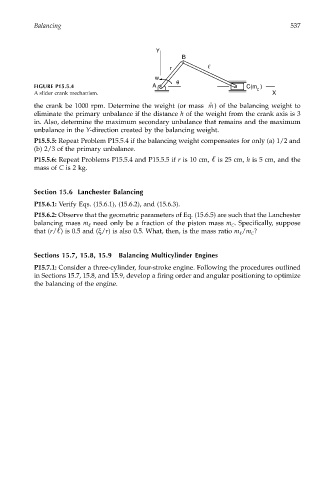Page 556 - Dynamics of Mechanical Systems
P. 556
0593_C15_fm Page 537 Tuesday, May 7, 2002 7:05 AM
Balancing 537
Y
B
r
w
θ
FIGURE P15.5.4 A C(m )
C
A slider crank mechanism. X
the crank be 1000 rpm. Determine the weight (or mass ˆ m ) of the balancing weight to
eliminate the primary unbalance if the distance h of the weight from the crank axis is 3
in. Also, determine the maximum secondary unbalance that remains and the maximum
unbalance in the Y-direction created by the balancing weight.
P15.5.5: Repeat Problem P15.5.4 if the balancing weight compensates for only (a) 1/2 and
(b) 2/3 of the primary unbalance.
P15.5.6: Repeat Problems P15.5.4 and P15.5.5 if r is 10 cm, is 25 cm, h is 5 cm, and the
mass of C is 2 kg.
Section 15.6 Lanchester Balancing
P15.6.1: Verify Eqs. (15.6.1), (15.6.2), and (15.6.3).
P15.6.2: Observe that the geometric parameters of Eq. (15.6.5) are such that the Lanchester
balancing mass m need only be a fraction of the piston mass m . Specifically, suppose
C
that (r/ ) is 0.5 and (ξ/r) is also 0.5. What, then, is the mass ratio m /m ?
C
Sections 15.7, 15.8, 15.9 Balancing Multicylinder Engines
P15.7.1: Consider a three-cylinder, four-stroke engine. Following the procedures outlined
in Sections 15.7, 15.8, and 15.9, develop a firing order and angular positioning to optimize
the balancing of the engine.

